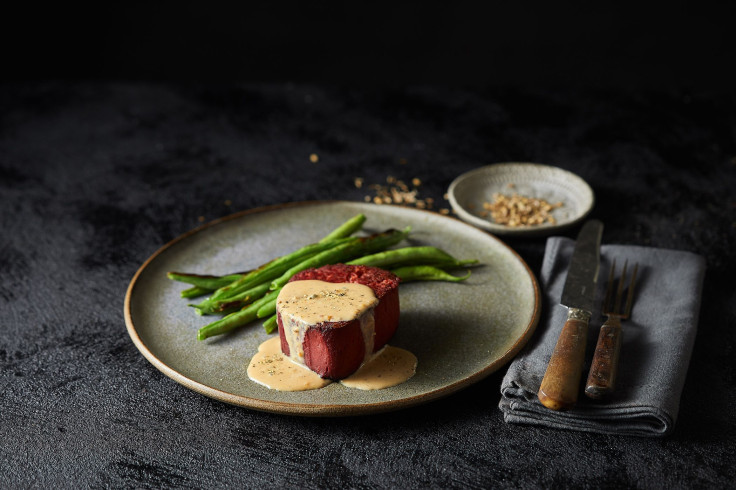Israeli Company Introduces 3D-Printed Plant-Based Steak

KEY POINTS
- Redefine Meat will test it's 3D printed steaks at high-end restaurants in Israel, France, Germany and Switzerland
- Talks are underway with retailers but a presence in grocery stores likely won't materialize until 2022
- The steaks are made from soy and pea proteins
An Israeli company Tuesday introduced the world’s first plant-based steak, created using 3D printing technology. Redefine Meat said its Alt-Steak will be market tested at high-end restaurants starting later this year.
“Since day one of the company, we have been working on creating a tasty and affordable plant-based alternative to steaks, one of the most cherished food products and the driver of the entire meat industry,” co-founder and CEO Eshchar Ben-Shitrit said. He called the announcement “the start of a new era in alternative meat” and predicted it will spur a shift to meatless foodstuffs.
Ben-Shitrit said 3D printing allows the company to build its steaks layer-by-layer, creating “satisfying flavors, textures and aromas” that remind one of actual meat.
Redefine Meat's 3D printers currently can produce 25-35 steaks an hour — 2.5 minutes for each steak — but the company hopes to scale up to 300 pounds a shift and operate 24 hours a day by the time it begins shipping to distributors early next year.
The 3D-printed steaks have the same nitritional value as those produced from livestock, with an equal amount of protein and fat and the added bonus of fiber, he said.
The meat substitute market is subdivided into segments: tofu, tempeh, textured vegetable protein, Quorn, seitan and others, made from soy, wheat and mycoprotein. The products are seen as more environmentally sustainable than the livestock industry. Redefine Meat's products are produced from soy and pea proteins, and are expected to be sold fresh, free of preservatives, priced comparably with traditional beef products.
Ben-Shitrit said other food companies are exploring 3D printing, as well, and is encouraging them to move forward
"We believe we are leading the way in this area, with meat products that are already ultra-realistic in terms of taste, texture, appearance -- which ultimately provide consumers with the same sensory experience that they enjoy when eating a conventional piece of meat. That said, we want to see a thriving ecosystem of 3D printed meat. Having other companies in the field will allow us to learn from one another. As a $1.5 trillion industry, the meat sector is big enough for everyone, and if we’re all successfully working towards reducing meat consumption, then that’s a win-win for global sustainability," he said.
Ben-Shitrit said the beauty of 3D printing is that by just downloading different files, you can produce almost any cut, depending on consumer feedback.
"If there is one defining thing that 3D printing is good at, it is creating unique products -- there is not penalty in speed or accuracy when changing from one file to another, so experimentation and mass-customization are definitely viable options," he said.
The first tests of the steak will be at high-end restaurants in Israel, France, Germany and Switzerland.
"Upon successful market-testing, we will scale up globally. Our goal is to work with experts who can give us feedback on our product quality, which is why we are targeting professional chefs with vast experience in handling and cooking meat," Ben-Shitrit said in response to a query by International Business Times. " While meat is ubiquitous, butchering differs around the world, leading to hundreds of different cuts with different preparation styles. These experienced chefs will be able to take on our new meat products and guide us on how to optimize meat production for each of these requirements."
Ben Shit-rit said texture proved the most difficult aspect of developing the steaks, saying if the color is wrong or there's a slight variation in flavor, consumers will downgrade their scores.
Talks with retailers are under way, but food stores will not be include in the first phase of distribution.
"Meat is a 1.5 trillion industry and beef is the most expensive part of it," Ben-Shitrit said. "We see a massive growth in the alternative meat sector and expect it to become a giant industry in its’ own right. ... Since we are creating a new high-quality category, which is uniquely premium and large scale, our plans are extremely aggressive from that perspective. 2021 will be our pilot year, but from 2022 onward, we are planning a global expansion on a massive scale."
Alternative meat products are a growing market. Predictions call for them to become an $8.1 billion industry by 2026 and $140 billion within a decade.
Beyond Meat (BYND) and Impossible Foods have been the recent darlings of the industry in recent years, making inroads at not only grocery stores but in fast food and casual dining restaurants. Neither, however, produces a steak.
Danny O'Malley, president and founder of Before the Butcher, said consumers are embracing alternatives to traditional meat.
"The biggest game-changer came a few years ago and has continued to evolve with the plant-based burger," he told IBTimes in an email. "A great plant-based steak would take plant-based meats to another level. We have seen such a huge demand for our line of chicken, turkey and breakfast sausage patties. The consumer need that producers have to meet is the demand for a variety of meatless meat products."
Yuni Sameshima, CEO and co-founder of Chicory, said traditional meat producers have recognized the potential in plant-based products, if nothing else, as a hedge to protect marketshare. Perdue, for example has a line of plant-based meat and Kellogg's launched IncogMEATo.
"There's real potential for traditional meat to become an afterthought, particularly in an increasingly climate-conscious world," Sameshima said.
© Copyright IBTimes 2025. All rights reserved.





















